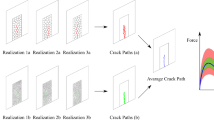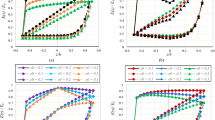Abstract
Concrete contains several components in the material, and the spatial distributions of its components strongly affect material properties. In particular, entrained voids in a concrete specimen are dominant in determining the material characteristics and its properties. The voids in a material have a significant effect in enhancing insulation performance of concrete, while the mechanical properties decrease as the porosity increases in general. Therefore, a proper investigation is needed to identify the effect of void characteristics in concrete. Here, the effect of void clustering on the responses of porous materials is evaluated. A set of virtual porous specimens with different void clusters are produced, and the probability functions are used to characterize their void distributions. The thermal conductivity and mechanical properties (i.e., elastic modulus) of the virtual specimens are examined numerically. The correlation between the void clustering and the material properties is confirmed and it is found that both thermo-mechanical properties of concrete decrease as the cluster size of voids increases.














Similar content being viewed by others
References
N. Narayanan, K. Ramamurthy, Structure and properties of aerated concrete: a review. Cem. Concr. Compos. 22, 321–329 (2000)
A.M. Neville, Properties of Concrete (Wiley, Chichester, 2012)
A. Tewari, A.M. Gokhale, J.E. Spowart, D.B. Miracle, Quantitative characterization of spatial clustering in three-dimensional microstructures using two-point correlation functions. Acta Mater. 52, 307–319 (2004)
B. Lu, S. Torquato, Lineal-path function for random heterogeneous materials. Phys. Rev. A 45, 922–929 (1992)
S. Torquato, J. Beasley, Y. Chiew, Two-point cluster function for continuum percolation. J. Chem. Phys. 88, 6540–6547 (1988)
A. Gokhale, A. Tewari, H. Garmestani, Constraints on microstructural two-point correlation functions. Scr. Mater. 53, 989–993 (2005)
S. Torquato, Random Heterogeneous Materials (Springer, New York, 2002)
A. Sales, F.R. Souza, W.N. Santos, A.M. Zimer, F.C.R. Almeida, Lightweight composite concrete produced with water treatment sludge and sawdust: Thermal properties and potential application. Constr. Build. Mater. 24, 2446–2453 (2010)
A.A. Sibahy, R. Edwards, Thermal behaviour of novel lightweigh concrete at ambient and elevated temperatures: experimental, modelling and parametric studies. Constr. Build. Mater. 31, 174–187 (2012)
S.-Y. Chung, M.A. Elrahman, P. Sikora, T. Rucinska, E. Horszczaruk, D. Stephan, Evaluation of the effects of crushed and expanded waste glass aggregates on the material properties of lightweight concrete using image-based approaches. Materials 10, 1354 (2017)
S.-Y. Chung, T.-S. Han, Reconstruction of random two-phase polycrystalline solids using low-order probability functions and evaluation of mechanical behavior. Comput. Mater. Sci. 49, 705–719 (2010)
R. Dorey, J. Yeomans, P. Smith, Effect of pore clustering on the mechanical properties of ceramics. J. Eur. Ceram. Soc. 22, 403–409 (2002)
R.C.K. Wong, K.T. Chau, Estimation of air void and aggregate spatial distributions in concrete under uniaxial compression using computer tomography scanning. Cem. Concr. Res. 35, 1566–1576 (2005)
R. Cabrillac, B. Fiorio, A. Beaucour, H. Dumontet, S. Ortola, Experimental study of the mechanical anisotropy of aerated concretes and of the adjustment parameters of the introduced porosity. Constr. Build. Mater. 20, 286–295 (2006)
S. Lu, E. Landis, D. Keane, X-ray microtomographic studies of pore structure and permeability in Portland cement concrete. Mater. Struct. 36, 11–20 (2006)
V. Cnudde, A. Cwirzen, B. Masschaele, P.J.S. Jacobs, Porosity and microstructure characterization of building stones. Eng. Geol. 103, 76–83 (2009)
C. Lian, Y. Zhuge, S. Beecham, The relationship between porosity and strength for porous concrete. Constr. Build. Mater. 25, 4294–4298 (2011)
S.-Y. Chung, T.-S. Han, T.S. Yun, K.S. Yeom, Evaluation of the anisotropy of the void distribution and the stiffness of lightweight aggregates using ct imaging. Constr. Build. Mater. 48, 998–1008 (2013)
S.-Y. Chung, M.A. Elrahman, D. Stephan, Investigation of the effects of anisotropic pores on material properties of insulating concrete using computed tomography and probabilisticmethods. Energy Build. 125, 122–129 (2016)
T. Mura, Micromechanics of Defects in Solids (Springer, New York, 1982)
S. Lee, J. Lee, B. Ryu, S. Ryu, A micromechanics-based analytical solution for the effective thermal conductivity of composites with orthotropic matrices and interfacial thermal resistance. Sci. Rep. 8, 7266 (2018)
S.-Y. Chung, T.-S. Han, Correlation between low-order probability distribution functions and percolation of porous concrete. Mag. Concr. Res 65, 448–460 (2013)
H. Singh, A. Gokhale, S.T.S.I. Lieberman, Image based computations of lineal path probability distribution for microstructure representation. Mater. Sci. Eng. A 474, 104–111 (2008)
D.A. Coker, S. Torquato, Extraction of morphological quantities from a digitized medium. J. Appl. Phys. 77, 6087–6099 (1995)
S. Lee, S. Torquato, Measure of clustering in continuum percolation: computer-simulation of the two-point cluster function. J. Chem. Phys. 91, 1173–1178 (1989)
O. Koroteeva, S. Mogilevskaya, S. Crouch, E. Gordeliy, A computational technique for evaluating the effective thermal conductivity of isotropic porous materials. Eng. Anal. Bound. Elem. 34, 793–801 (2010)
J.J. Zhao, Y.Y. Duan, X.D. Wang, B.X. Wang, A 3-d numerical heat transfer model for silica aerogels based on the porous secondary nanoparticle aggregate structure. J. Non-Cryst. Solids 358, 1287–1297 (2012)
S. Wei, C. Yiqiang, Z. Yunsheng, M.R. Jones, Characterization and simulation of microstructure and thermal properties of foamed concrete. Constr. Build. Mater. 47, 1278–1291 (2013)
C. Bi, G.H. Tang, Z.J. Hu, Heat conduction modeling in 3-d ordered structures for prediction of aerogel thermal conductivity. Int. J. Heat Mass Transf. 73, 103–106 (2014)
ABAQUS, Version 6.13, Dassault Systemes, Pawtucket, Rhode Island (2013)
N. Bilger, F. Auslender, M. Bornert, J.-C. Michel, H. Moulinec, P. Suquet, A. Zaoui, Effect of a nonuniform distribution of voids on the plastic response of voided materials: a computational and statistical analysis. International Journal of Solids and Structures 42, 517–538 (2005)
Acknowledgements
This research was supported by a National Research Foundation funded by the Korean Government (NRF-2016R1D1A1B03931635). The project was also supported by the German Federal Ministry of Education and Research (BMBF, Project number: 01DR16007)
Author information
Authors and Affiliations
Corresponding author
Additional information
Publisher's Note
Springer Nature remains neutral with regard to jurisdictional claims in published maps and institutional affiliations.
Rights and permissions
About this article
Cite this article
Chung, SY., Kim, JS. & Han, TS. Effects of Void Clustering on the Thermal and Mechanical Properties of Concrete Evaluated Using Numerical Methods. Multiscale Sci. Eng. 1, 196–209 (2019). https://doi.org/10.1007/s42493-019-00017-1
Received:
Revised:
Accepted:
Published:
Issue Date:
DOI: https://doi.org/10.1007/s42493-019-00017-1




